|
beauty:
hair

Oribe Canales is the star hairdresser who
has been credited as one of the creators of the supermodels (that’s
Christy, Naomi and Linda) and works regularly with Jennifer Lopez.
Vivian Galtier Kelly senses his charisma and learns why some
of the fussiest clients will wait a year just to see him
From
issue 14 of Lucire
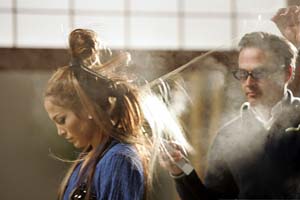 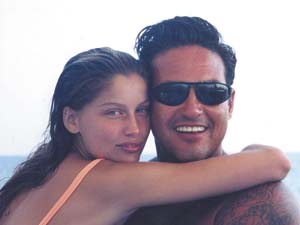
ORIBE CANALES has star quality. For one, he is shockingly good-looking.
But it’s more than that: he has the X-factor, charisma. One is immediately
aware of his presence; and once you look, you can’t stop looking
at him. Sitting in the small office of his new, glittering Miami
Beach salon, hairstylist Oribe Canales looks like a movie star,
perhaps Rudolph Valentino crossed with his favourite, Robert de
Niro. He’s dressed in all black, he’s fit and tanned and his hair
is still almost completely jet black. His tanned arms are tattooed
from top to bottom, thus saving him from being merely pretty. Had
he not chosen hairstyling as his career, he would have been an actor.
Oribe delivers, unlike so many of his famous and
not-so-famous colleagues. Delivering on the promise of beauty has
earned him the love and loyalty of legions of women, from all different
walks of life and ages. He understands and fully agrees that a woman
should leave the salon feeling like a million dollars, like she
is the most beautiful woman in the world.
Unfortunately, many leave the salons they patronize
feeling ho-hum, slightly dissatisfied, or worse, angry and upset.
The quest for beautiful sexy hair is more often than not an itch
that doesn’t get scratched. Women, such as video producer, Karen
Morrison, of Mod-TV, and the long-time producer of Allure Backstage,
will go without a haircut for months on end until they can have
their appointment with Oribe. Ms Morrison travels all year round,
residing in New York, Paris, Italy, and Canada and declares, ‘Oribe
is my favourite hair stylist in the entire world. No one knows how
to cut long hair like him! He understands the meaning of sexy—and
the way he cuts hair is beyond. I have tried for a year to see him
and have been tortured with bad haircuts that I tried in between.
I’ve stopped letting anyone cut my hair until I can see him again.’
Gail Spiegel divides her time between her homes
in Connecticut, Manhattan, and Jupiter Beach, Fla. and has been
to them all: Garren, Kenneth, Peter Coppola, and just about every
star stylist in Manhattan. No one, she tells Lucire, can
rival Oribe. ‘I was looking for a hairdresser, and someone suggested
I go to Elizabeth Arden; and they booked me with Oribe. He cut my
hair, and that was it, it was unbelievable. It was the best haircut
I’ve ever had. Every hair just fell into place. I remember when
I left the salon that day, people were turning around to look at
me in the street all the way home! I never had experienced that
before. No one [else] comes close to making a woman feel sexy and
beautiful.’
He is, despite some bumpy recent years, now and
always, a star. Oribe is back, after a rash of dark years at the
end of his time at his Fifth Avenue Elizabeth Arden salon. He’s
open and in touch with himself. ‘Personally, I’m in a good place,’
he remarks. ‘I just went to my high school reunion, and it’s a shock
to me to see how old I am. I feel like the same 22-year-old guy
driving in a Jeep who was on top of the world back then. I enjoy
what I’m doing, and I still have that enthusiasm to do something
incredible.’
Oribe’s story reads rather like that of his new
home. Miami Beach went from being an international hot spot in the
early ’90s, and suffered a precipitous drop in popularity after
Gianni Versace was gunned down in front of his South Beach palazzo.
It‘s been a long hard road back, but Miami Beach is hotter than
it ever was. Oribe was the king at the beginning of the ’90s, lost
popularity in the mid-’90s due to "minimalism" (in the
hair world, straight, stringy, greasy hair) and well chronicled
episodes of substance abuse. Recently, however, he’s put himself
back on track, and opened a sparkling state-of-the-art salon on
Euclid Avenue, right off trendy Lincoln Road, in the heart of pulsating
South Beach, Miami. The salon is not the only thing that sparkles.
Oribe himself looks healthy, fit, and happy.
On a trip to South Beach this autumn, to attend
the shows, we had the privilege of sitting down with Oribe for a
chat. His is a story so replete with names that it reads like a
Who’s Who in the world of fashion. He also spoke about his
shiny new salon, what it’s like to work with Jennifer Lopez, and
his plans for the future.
Lucire: When did you first realize that you loved doing
hair? Who were your influences?
Oribe: As a kid growing up in the Carolinas, I did whatever I wanted,
so I stayed up late all the time watching The Beverly Hillbillies.
I loved Ellie May, the ’60s’ Raquel Welch, all the black and white
movies. Julie Newmar was in this robot show that aired for one season.
She was genius! I loved the way she looked.
On Christy, Naomi and Linda
The collaboration between Oribe, François Nars and celebrated
photographer, Steven Meisel, is the stuff of which fashion legends
are created: they were fashion’s dream team. It is pretty much universally
acknowledged that "the Supers", a.k.a. the original supermodels
(most famously, Christy Turlington, Linda Evangelista, and Naomi
Campbell) were a product of the collaboration between these three
artists.
No one will ever forget the supermodels. Models have never been
so famous. You were one of the creators of "the Supers".
Was it a conscious collaboration? How did it come about?
Steven [Meisel] was the ringleader, François [Nars, the iconic
makeup artist] and Carlyn Cerf [the fashion stylist]. I worked with
Steven for five or six years every day, he’s a wonderful talent.
These young girls were coming around [and] they were unusual. They
were the celebrities of the time and they had the personalities.
[François Nars has a history of working
with Oribe. He is the make-up artist who put forward and popularized
his revolutionary approach to modern make-up, namely that ‘make-up
is not a mask and that the woman must shine through.’ Nars comments,
‘It was a lot of fun for all of us, but also very hard work "creating"
those girls. We all came up with the girls’ looks, it was really
teamwork.’]
What was François Nars like to work with?
François is my hero; he did it like he dreamt it and wanted
to. François has Shiseido behind him, you go to any counter
and it’s still the coolest. He’s doing clothing for Nars, soon to
be revealed.
Who was your favourite girl?
Christy: she had the face and personality. That kind of face and
personality doesn’t come around very often. She had that face of
no ethnicity, a kinky face. I’d go out with her and people would
walk up to her and ask who did her nose. She’s so smart and hysterically
funny, and never took herself seriously, wanting to be a movie star.
She’s got two clothing lines now, Nuala and Maha Nuala.
Naomi and I are still very, very close. She’s
very misunderstood. I hand it to her for living the life we depict
in magazines. She’s a businesswoman, the first to show up when someone
dies. She works the phone: if I call her right now, I can still
get a hold of that girl. Linda E. looks incredible. I haven’t worked
with her for 10–12 years; I worked on Dutch or German Vogue
with her. She lives in New York.
What was your favourite photo shoot from this time?
It had to be the Comme des Garçons campaign with Christy
T. when she looks like a little animal with little leaves. She looked
like an alien.
You’ll never be forgotten for the work you did glamming up the
Versace runways.
I loved those shows … When Suga [a hair superstar of the ’70s who
worked closely with the Versaces] passed away, it was suggested
to the Versaces that I work with them. That began in the early ’90s.
Through them I got a lot of salon business and advertising. Linda
was very much the Versace diva. The Versaces were generous with
talent, and allowed you to create a woman that was glossy and beautiful.
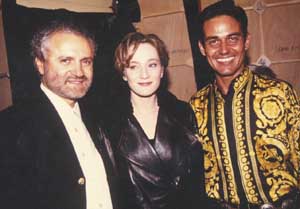
Then there was [the] minimalism era. What I learned
is that [glamorous beautiful hair] will always come back. There
[are] always prostitutes and go-go dancers in the meantime. They
have and will spend the dollars. The crazies have always loved me.
What would you do if you didn’t do hair?
I’d be an actor, like de Niro. I came to New York in 1976, [and]
worked at a cabaret and all that but didn’t want to do all [the
hard work]. I lacked the discipline. I went into hair-cutting instead,
as a receptionist, when I saw how much money they made and thought
it’d be good and finished in Buffalo. One night I was out at a club
and met Garren. He was interested in how you looked rather than
if you cut hair. He hired me as a personal assistant for his place,
Garren at the Plaza. He was never in the salon; one week later I
was on the floor. He was shooting for Vogue and Glamour,
I learned how to act around these people. You have to kind of feel
it out around these people.
What do you think of Garren’s infamous waiting list? It can
be as long as one year.
The waiting list, yeah. I know Garren from Niagara Falls, when he
was Garren Di Fazzio. I moved on to Leslie Blanchard, a colour salon;
we did Meryl Streep, Jodi Heatherton. I would blow them out; I learned
how to get fried hair from too much colour looking beautiful. It
helped me with my craft. After a move to California, I went back
to Garren. I was 22 and really dark from being in an open Jeep.
You have a huge body of editorial work. How did you get that
work?
I was the hairdresser in a shoot. Thom Priano got tired of doing
men’s grooming on magazine shoots. I became the men’s guy for GQ
and then they’d throw a girl in like Teri Farrell, so I got to do
some of the female models. There were so many hairdressers like
John Sahag. Teri F. introduced me to Bill King—he was out of his
mind but he liked me. I got four to five French Elle covers,
and he always put the wind on it. It was amazing how these covers
helped me get more work. Avedon had a whole new idea for Self.
We built our relationship; Keesha Keeble introduced me to Steven
Meisel who switched from Julien D’ys to me. Avedon never really
knew my name and I would answer to ‘Rafael’. I made his pictures
look modern and easy. I did that big lion mane thing for him, without
the wigs he usually used. I was very ambitious: I had the Parachute
Salon on the Westside on 76th Street and Columbus Avenue, and would
do business meetings all the time. The others would laugh at me
because I was so driven.
The showcase salons
Over the course of his career, Oribe has had two highly notable
salons. Each reflects two different periods of the stylist’s life.
They are like night and day. The first, in Elizabeth Arden’s Red
Door, in midtown Manhattan, was modelled on a Venetian Palazzo.
It opened in 1991 and came with a $3 million price tag; it defined
the word bling.
How did you hook up with Elizabeth Arden? Everyone in the ’90s
in New York knew your salon.
I met Vendela who introduced me to the owner of Fabergé who
owned Arden at the time. They were revamping the Red Door, and they
offered me the dream salon. I saw the 10th floor—those balconies!
There were millions and millions put into it. I wanted something
super-glamorous. My best friend Tony Santesero, a designer, killed
the postmodern thing we started with, and instead he designed the
beautiful Venetian thing in one month. I had it for 10–12 years.
Not once did I walk in and not love it.
The comeback: the new salon
Six months ago, Oribe borrowed the money to open a $1 million salon
in Miami Beach at the tourist-clotted intersection of Euclid Street
and Lincoln Road. It is a shrine dedicated to the beautification
of the women who step inside.
The Euclid Street salon is sparkly, yet toned
down, and in control. It’s coolly edgy yet warmly inviting, much
like Oribe himself. According to an article written by Ruth La Ferla
for The New York Times, Oribe’s client list has expanded
in recent months to include the likes of Céline Dion, Gwyneth
Paltrow and Penélope Cruz. Editorially, things are looking
up as well. The high-profile print assignments are coming in again,
and there are the collaboration with Jennifer Lopez and campaigns
with Redken.
This new salon is obviously very special to you. Why?
This salon is something new for me; it’s my third in Miami. I had
the Coral House in Miami. It was very cute but this is the first
serious salon for me. I wanted to put all my energy in Miami. The
theme would be clean and shining. We started to do modern and it
started getting boring. The floors [all metallic] have been done
been done three to four times, but it’s worth it, it takes the seriousness
away from the minimal. You need to get more than a haircut.
You’ve redeveloped the product and packaging on your product
line. Your personal assistant said there is a complete line in the
works. Who are you working with and what are your plans for distribution?
The wax I did way back in the ’90s still has a cult following. What’s
on the shelves is still very temporary. I’m creeping forward, and
I want to do something that’s me. I went to a psychic and was very
frustrated with my ventures. He said, ‘Just package yourself,’ and
that’s what I’m doing. What I love is beautiful hair, deep shine
and the core of the hair being really beautiful. I’m working with
a great chemist in Texas. I have a column in People en Espanol
where I push all kinds of products. I can say whatever I want
to say, within the People magazine format.
Jennifer Lopez
With a successful new salon, a redeveloped and repackaged product
line, and a continuing collaboration with J. Lo, Oribe’s future
is looks promising, even rosy. The diva had her eye on the hair
star for a very long time, starting while she was growing up in
the Bronx. She told Oribe that growing-up that she would always
read his credits in the fashion magazines, and loved the hair he
was creating for the photo shoots. When it was time to do her first
album, she asked for Oribe. It was then that he came up with what
he calls ‘the softening look, brown with honey highlights.’
You’ve credited Jennifer Lopez with helping you with your comeback.
Do you see her as an influential player in the fashion and beauty
scene? Why do you think so many women relate to her and buy her
products?
I have to give her credit: we never do the same hair twice. She’s
like the movie stars of the ’60s who set trends. She knows every
movie star there ever was. She’s everything: a movie star persona,
pop star, and she’s open to it all. That’s the reason she’s a fashion
icon. If Anna [Wintour] said, ‘Bob your hair,’ she’d be the first
one not to do it. All the pop stars looks like she did three years
ago. Her look is sexy, commercial yet outrageous. She doesn’t put
it on ever; she’s a very streetwise girl from New York.
Getting personal
Ruth La Ferla wrote that fantastic article in The New York
Times and now there’s a book in the works. It’s been difficult
for you in the past but you are clearly in a new phase of your life.
What made you decide to do the book?
I had a few agents call me after the Times article. I think
I could have a very cool book; it’s an important era I could focus
on. It would be an amazing upbeat story about New York fashion,
my take on it, and it would be very honest. It doesn’t come from
an angry place: I had a very interesting journey through it. I read
Anthony Bourdain’s Kitchen Confidential, and was inspired
by it. My book wouldn’t be a gossip book, nothing that would offend
anyone. It’ll be inspirational to young kids who want to come to
New York.
Who is your support system?
Zaki Amin is my agent and business partner. Artistic people need
it. Judi Erikson is still in New York and has been with me for 12
years—people think we’re husband and wife. We’re on the road so
much together!
What are your plans for the future?
Creatively, I just want to keep doing shootings; celebrities are
excited about working with me. My range is big. I’m not a therapist,
a woman tells me something, and I just laugh it off. Professionally,
in my salon I can do what I want. Personally I’m in a good place,
Once you don’t enjoy it any more, you’re not good any more and you’re
just doing it for the money. I still have that enthusiasm to do
something incredible. Scarlet Johansson and I are doing the Elle
cover December or January. I worked with Terry Richardson for Vogue
Italia with Naomi. It was really gorgeous. This is the first
big season for us in the new salon. The Spa–E collaboration worked
well, so I can specialize in haircutting and styling.
Where to from here?
As to Oribe’s future, Francois Nars puts it best. ‘Women will always
want to look beautiful and attractive. They will need somebody like
Oribe because he loves women and I believe his only drive is to
make them sexy, gorgeous and as beautiful as possible. That is the
vision he has in mind all the time. Not too many people have that
today. That’s why there is only one Oribe.’ •
Comments
|
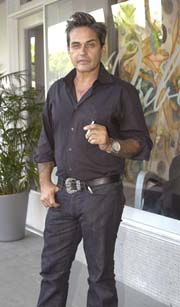
Photo credit: Richard Spiegel
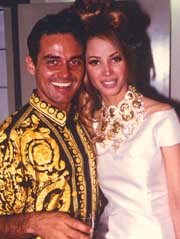 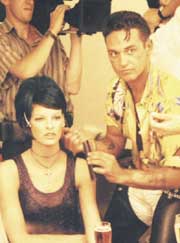
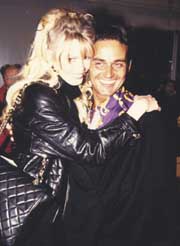 
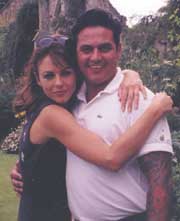
|

